The ‘prayer mile’: how the City of London’s churches were saved
Simply sign up to the Life & Arts myFT Digest -- delivered directly to your inbox.
The City of London, the UK capital’s traditional financial district, is diverse and thrilling architecturally. Founded in AD47, it is the oldest part of London. Roman remains, medieval lanes and imposing civic and livery buildings, coexist alongside contemporary office blocks, many designed by leading British and international architects. Within this rich tapestry are the City churches, each one a masterpiece. As a group, they set London apart from every other city in the world.
Architectural historian Gavin Stamp says he “cannot think of an equivalent [city]”. He believes “that the City churches are an astonishing [story of] survival against the odds, and the greatest concentration of 17th-century architecture anywhere in Britain, wonderful in their variety and invention”.
Built on the medieval sites of churches damaged during the Great Fire of London in 1666, this concentration of 17th-century architecture was created by Christopher Wren and his assistants.

Before the fire, there were about 100 churches in the Square Mile. Afterwards, 86 of them, as well as St Paul’s Cathedral, were left destroyed or unusable. Wren was already working on the redesign of St Paul’s for Charles II when the fire broke out.
His proposal to rebuild London based on a regular plan like Paris, with wide streets and classical buildings, was rejected by the king because it was too ambitious and expensive. Instead, 51 churches, funded by a tax on coal, were to be built as quickly as possible.
Wren, a brilliant scholar, studied building construction and classical architecture. And inspired by the classical Baroque buildings of Paris and Rome, he worked in an architectural tradition that had far more in common with Europe than England.
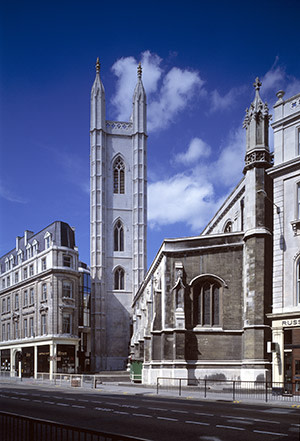
Colin Amery writes in his book Wren’s London (1988) that the “city churches are key to Wren’s development as an architect”. In his designs for the spires, each added decades after the rebuilding started, we see his growing interest in evoking the Baroque, as well as his ingenuity as a designer develop. The spire of St Vedast, for example, has concave and convex wall surfaces, a common Baroque feature. The glory is that every spire is different, and many resemble miniature classical temples.
The exteriors of the Wren churches are plain, often incorporating the surviving fabric of older churches, and usually with just one “show” elevation. The interiors were designed on variations of two “plan forms”: a rectangular plan broken into traditional aisles and nave, or a central plan, as with St Mary Abchurch, where the dome sits above an almost perfect square.

Roman influences are clear, particularly in his bigger churches — St Bride’s, in Fleet Street; St Andrew Holborn; and Christ Church Newgate Street — which were based on the design of Roman basilicas with barrel or groin-vaulted ceilings and three-aisled interiors. Wren took a pragmatic approach and designed new churches to suit their existing site, incorporating the surviving fabric and parishioners’ wishes. At St Mary Aldermary, in Watling Street, for example, Wren used the gothic elements to match the surviving tower and to meet the wishes of the patron. The internal fittings of the churches, their galleries, pews, pulpits, and altars were financed by individual parishes, and made by craftsmen. The Grinling Gibbons reredos — or altarpiece — at St Mary Abchurch is perhaps the finest piece of woodwork in all the City churches.
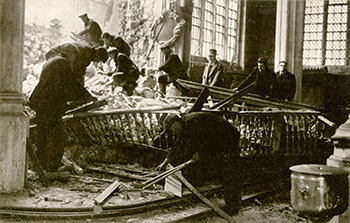
If the two ruined churches — Christ Church Newgate Street and St Dunstan in the East — are excluded, as well as the seven that exist only as towers, then the total number of surviving City churches is 40. Despite the overriding impact of Wren — 23 out of these 40 can be ascribed to his office — it is important to remember that other City churches predate the Great Fire (and Wren) and a few escaped it, including St Bartholomew the Great, in West Smithfield; St Olave’s and St Katharine Cree. Some were established in the 9th and 10th centuries, though the only surviving Saxon fabric is at the west end of All Hallows by the Tower. A Norman crypt survives at St Mary-le-Bow, unearthed during the restoration of the Wren church after the second world war.
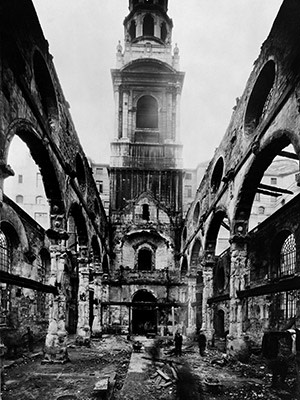
That any survive at all is remarkable. The threats have been relentless. In 1860 the passing of the Union of Benefices Act resulted in at least 14 demolitions. Created to cope with the loss of congregations after the flight of city residents to the suburbs, the Act allowed City church sites to be sold to pay for new churches in the suburbs. All Hallows, Bread Street, for example was removed to make way for warehouses. German Zeppelins caused further damage during the first world war. But it was the Blitz of the second world war that had the most devastating impact. Historian Juliet Gardiner gives details: “On December 29 1940 the City of London was bombed from 6pm to midnight with more than 300 incendiary bombs a minute falling in the area around St Paul’s . . . and over the course of three hours 120 tons of high-explosive bombs were dropped . . . the fires burnt for two days.”
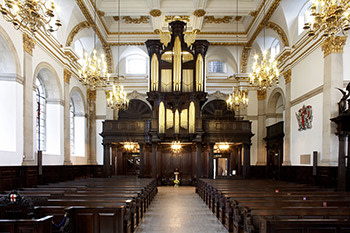
Many of the churches seen today: St Lawrence Jewry, St Mary-le-Bow, St Vedast and St Bride’s, to name a few, are barely Wren, but postwar reconstructions. For an era focused on rebuilding Britain in the language of modernism, this may seem extraordinary. Yet Oliver Leigh-Wood, chairman of the Friends of the City Churches charity, believes “these are buildings that have always inspired people to jump to their defence”. Founded after the second world war to encourage the restoration of bombed churches, the charity sat dormant until the Templeman report of 1994 proposed the closure of two-thirds of the City churches. Marcus Binney, a champion of threatened buildings, recalls it as “a very serious emergency”. He felt the churches “should continue to play a major part in the life of the city”.

Binney and Leigh-Wood led the reinvigoration of the organisation as soon as the threat of church closures emerged. This year marks 20 years of church “watching”. The “watchers”, a platoon of volunteers with a vast knowledge of the city, welcome church visitors, helping the vicar or manager to keep them open. Today, the Friends of the City Churches carries out “watches” at 17 churches, distributes grants and promotes awareness of these buildings. Its mission is supported by the Bishop of London, Richard Chartres, who believes that the City “churches are not a problem but an opportunity for some fresh and imaginative Christian work”.
Martin Sargeant, head of operations for the Archdeacon of London, believes they are almost better used now than ever before. He cites St Mary Aldermary as an example, describing how at any time of day you will find people using the café, holding meetings or praying quietly.
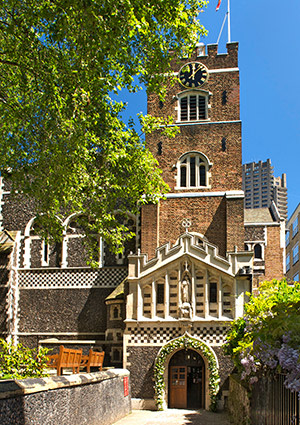
Yet even if the threats have subsided, challenges remain. The churches do not charge entrance fees, so heating, lighting, insurance and maintenance costs must be met from other sources. Funds for capital projects are required as well — St Mary Woolnoth, Nicholas Hawksmoor’s only City church, needs £3m to repair its roof and tower, for example. If the work is not undertaken, it could face closure on health and safety grounds.
The diversity of the City’s churches is a joy. Yet these buildings are now in competition, not just on the skyline, but as visitor attractions. Office-block skyscrapers are popular tourist destinations. One can only hope that future generations will come to the City churches’ defence, and keep them open, relevant and thriving.
Photographs: David CC/Alamy; Bildarchiv Monheim GmbH/Alamy; Grazyna Bonati/Getty Images; Lebrecht Music and Arts Photo Library/Alamy; H Bedford Lemere/English Heritage; View Pictures/Alamy; Chris Lawrence Images/Alamy; Eric Nathan/Alamy
Comments